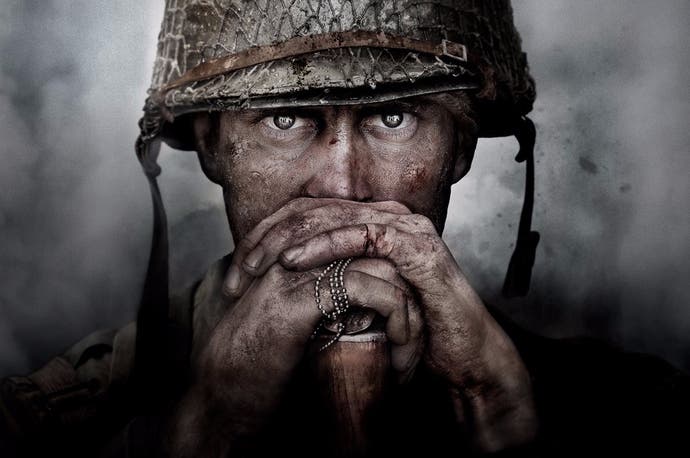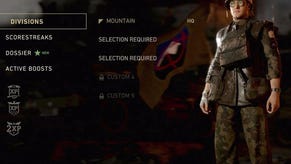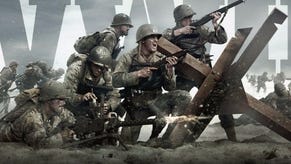Can Call of Duty: World War 2 improve on one of gaming's fastest engines?
Digital Foundry gets to grips with Sledgehammer's PS4 and Pro beta code.
It's only a tiny slice of the final product of course - a taster of three years' hard graft from one of the most respected developers in the business - but the arrival of the Call of Duty: World War 2 beta gives us our first look at how Sledgehammer Games has evolved one of the most significant console engines of this generation, and how its work scales between PlayStation 4 and PS4 Pro.
The solid technical foundation of 2014's Call of Duty: Advanced Warfare has served several developers well over the last three years. After the disappointment of Ghosts, Sledgehammer's extensive rewrite of the COD engine truly leveraged the capabilities of current-gen systems. Its revision pushed the series to a new, more filmic post effects pipeline, materials-based lighting, and vastly improved facial animations. Performance was also exceptional, running smoothly across all platforms and scaling beautifully across PC hardware configurations.
Since then, evolved branches of that COD engine have powered the excellent Modern Warfare Remastered, with the most dramatic improvements beyond that found in Infinite Warfare (this presentation on how it pushed the tech is well worth a read). But those titles also diverged in how they supported PS4 Pro: MWR favoured a simple resolution upscale to 2880x1620, while the more ambitious Infinity Ward release offered up checkerboard rendering, temporal super-sampling and dynamic scaling, deeply integrated into the pipeline for a more full-on approach to getting the most out of the Pro's GPU. So how has Sledgehammer itself pushed on the engine?
As always, we need to bear in mind that we're looking at beta code here - and Advanced Warfare improved dramatically between earlier showings and final release. Certainly in terms of its PS4 Pro utilisation though, World War 2 opts for the Modern Warfare Remastered approach almost point for point. Pixel counts on World War 2 resolve at the same 2880x1620 - or something very close to it, representing a 2.25x boost to the base PS4's resolution, an almost linear match to the increase in the Pro's compute power. There's no checkerboarding or dynamic scaling in effect that we could find - the sense is that Sledgehammer has built the 1080p experience up for base hardware first, then zeroed in on the best resolution boost it could find for the cleanest and simplest Pro upgrade.
Integrated into an accomplished post effects pipeline, the results looks good on a 4K screen - just as Modern Warfare Remastered did - but clearly it's some way off native resolution. Also a touch frustrating is that the current beta code appears to offer up very little to Pro users connecting up their consoles to 1080p screens. In this scenario, we noted no evidence of downsampling - the game's presentation looks really close to the base PlayStation 4's output here.
Looking past the pixel counts, the engine features still have a considerable overlap with some of Infinite Warfare's key rendering features. Photogrammetry is again used to give the game its impressive materials-based lighting - taking the physical properties of real world weaponry and vehicles and translating that to the game engine. And even in multiplayer - where key engine upgrades tend to be dialled back in the name of performance - the post effects pipeline shines, particularly with its per-object motion blur and depth of field. As always with the COD series, we should expect much more in terms of technical ambition from the campaign, where the more linear approach to gameplay allows the developers to make more of their render budgets. Trailers to date look impressive, and certainly stacked up against this multiplayer turnout, there's a sense that the engine has much more to give once we get to see the full package.
Performance-wise, it's business as usual for COD multiplayer, whether you're playing on base PS4 or Pro. Call of Duty's always been stubborn with its push for 60fps: it's not always been faultless, but certainly compared to Battlefield, the consistency in performance is admirable. World War 2 follows that trend to a tee - 60fps for most of the time on Pro, but with drops to 55fps when players activate alpha-heavy killstreaks.
Even in its beta state this is very playable, but it's interesting to note that whether you're gaming at 1080p or 1620p on the supercharged PS4, the results are very similar. Standard PS4 performance is essentially on the same level as well; you still get a strong 60fps, and firing at an enemy, you get a second or two dip to 55fps once those particle effects start flying - though an outlier in Killcam playback did see one 45fps dip during our tests.
Drops in performance are barely noticeable in the beta code, but the question is the extent to which they may stack up once the full extent of the multiplayer action rolls out - and this is just a limited sampler, remember. The real litmus test will be when players get access to the full range of weapons in that progression system, and really let loose in the days and weeks after its full release.
There's perhaps the sense that the various dynamic scaling technologies Infinity Ward rolled out for Infinite Warfare may have had a benefit here. Based on what we've seen so far, World War 2 doesn't have the same frantic pace as Infinite Warfare - nor the over-the-top weaponry and abilities we saw in that game's multiplayer, but neither does it quite have IW's dogged lock on its 60fps target. But what we do have are more organic environments, maps based in France and Germany that demand more nuance - more sculpting and refining of geometry than the more clinical areas of Infinite Warfare. It's a difference in style that changes the way the engine is used and where the emphasis in development may lie.
We had plenty of fun with the beta, but in common with prior COD test runs through the years, we can only really consider this as the smallest of samplers of the game to come. There's still so much we don't know about Call of Duty: World War 2, specifically in its campaign mode. Given Advanced Warfare's visuals and how Sledgehammer pushed the core COD technology back in the day, we're really looking forward to the approach it takes for the single-player portion of the title.










